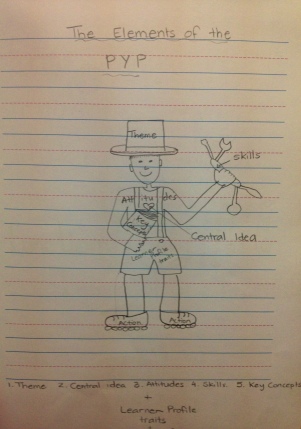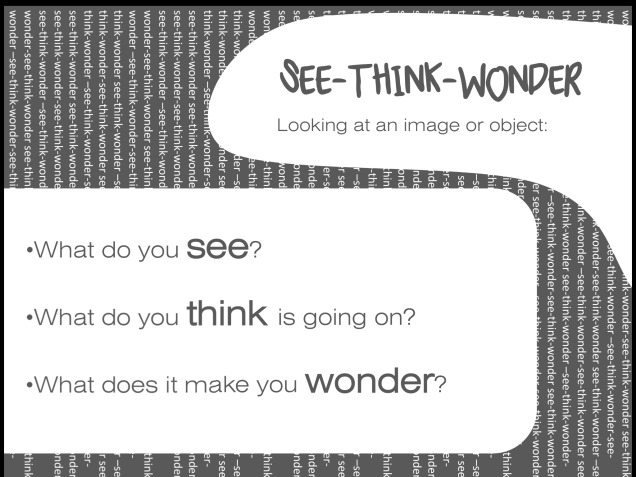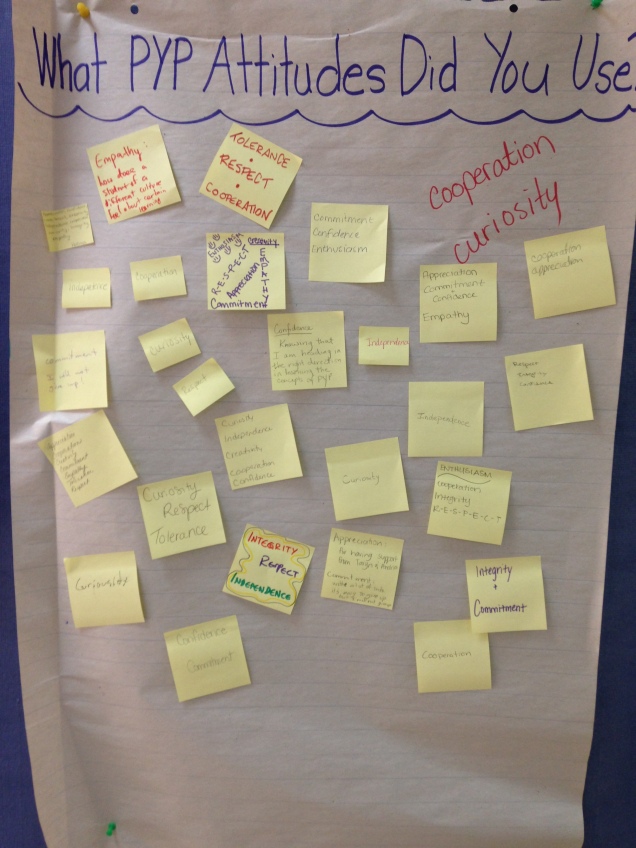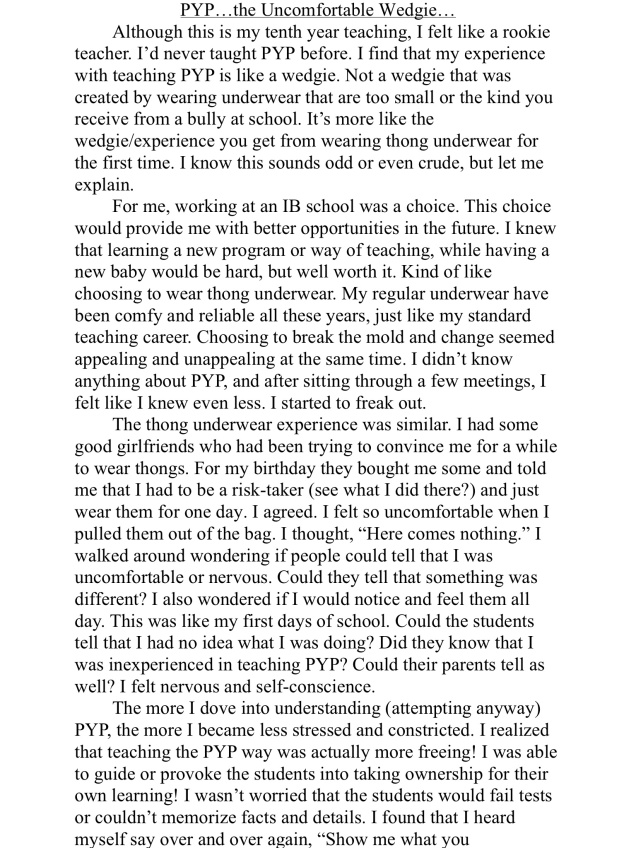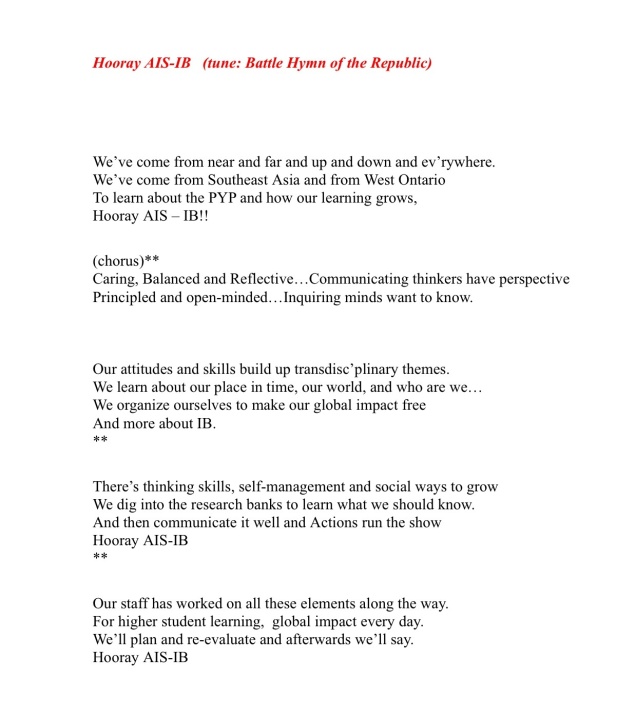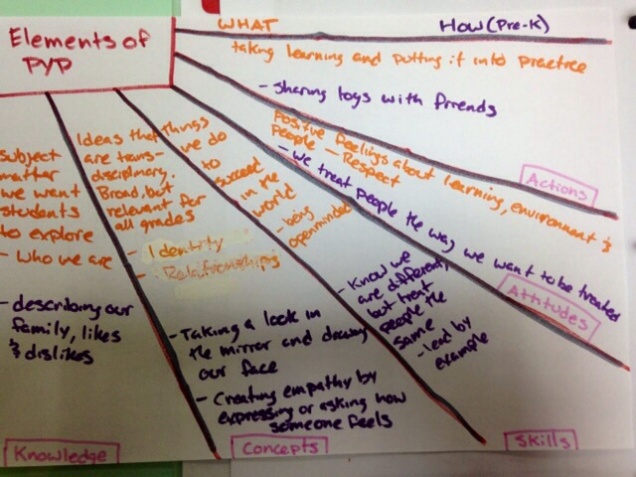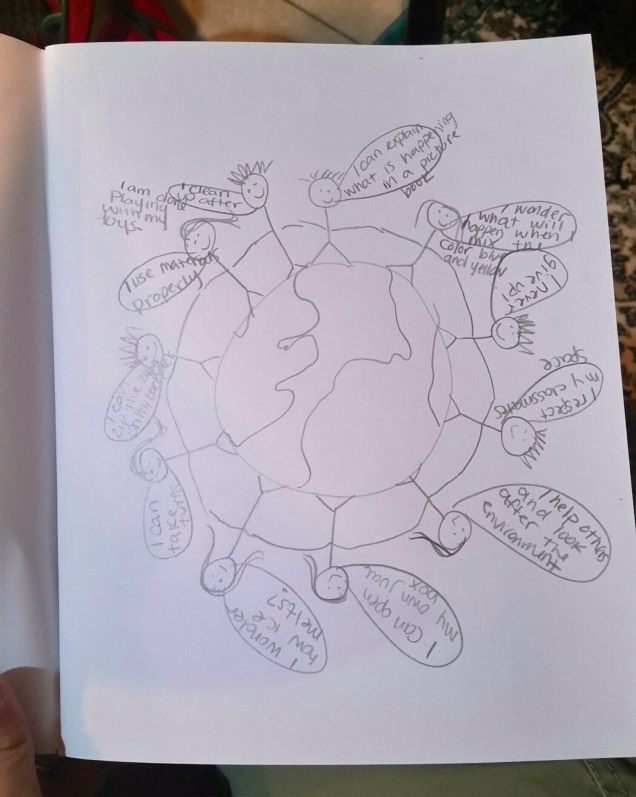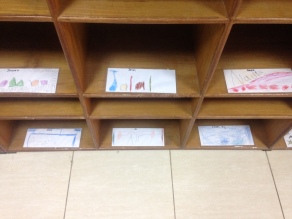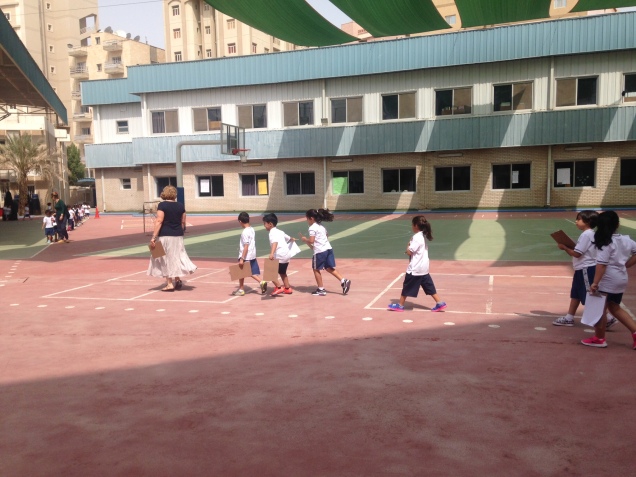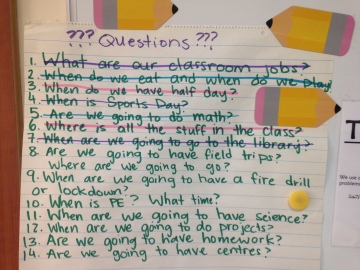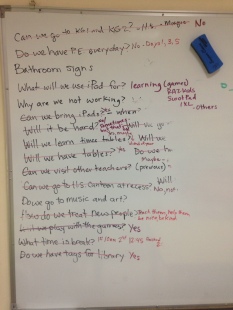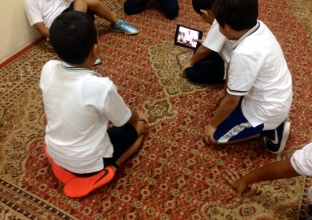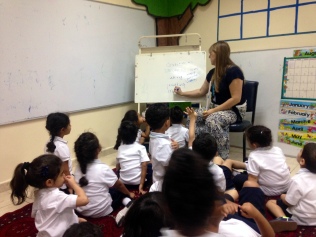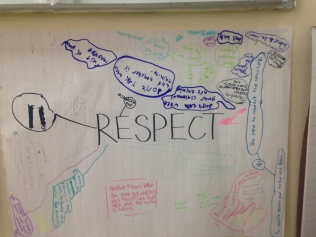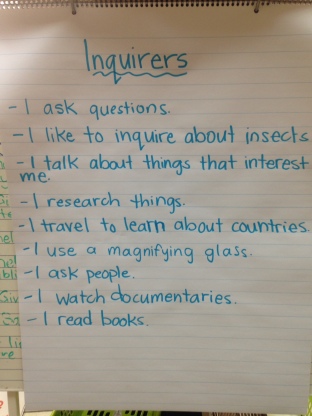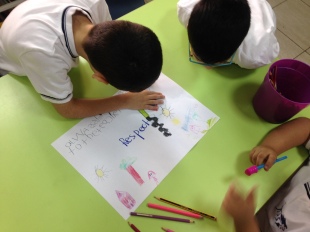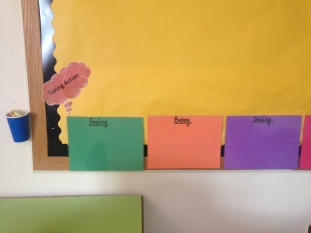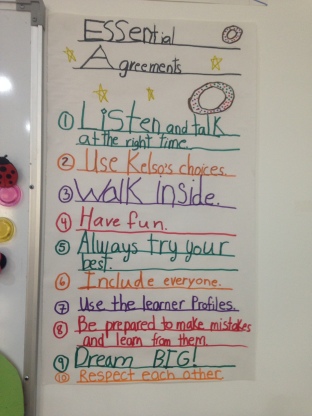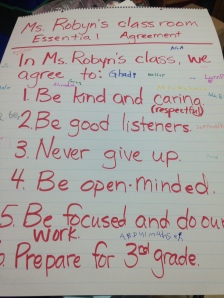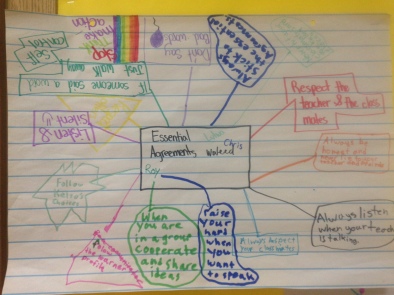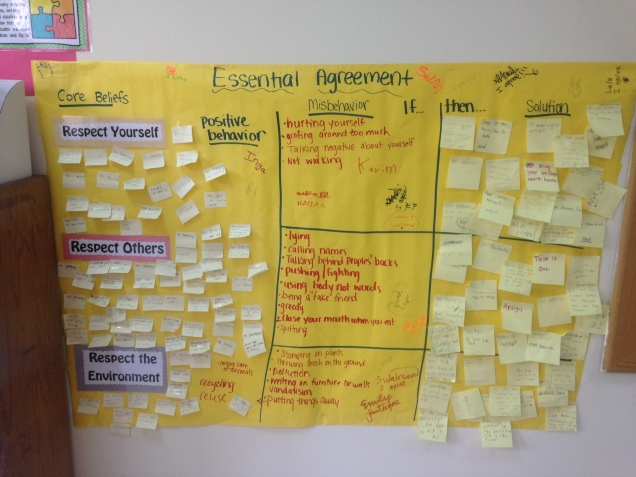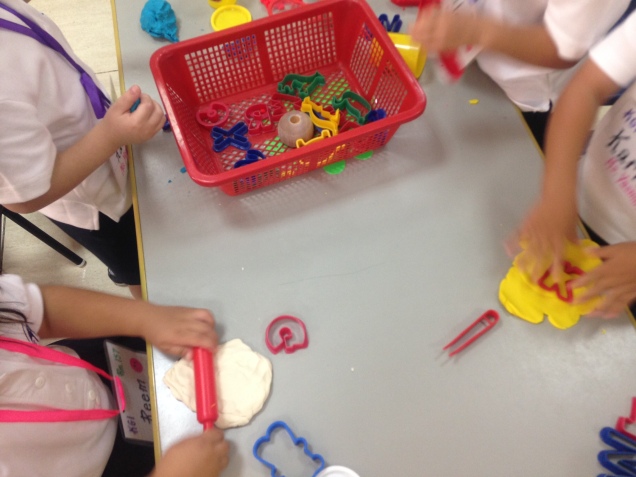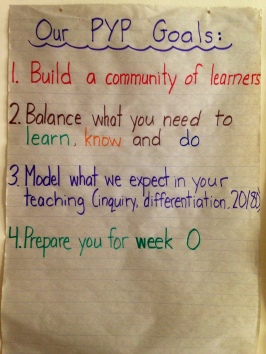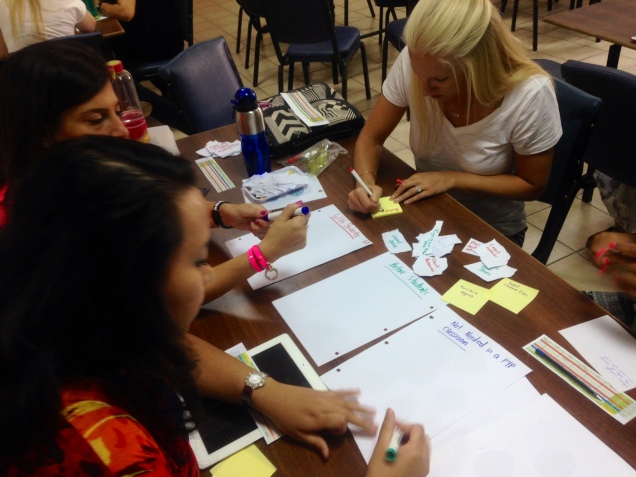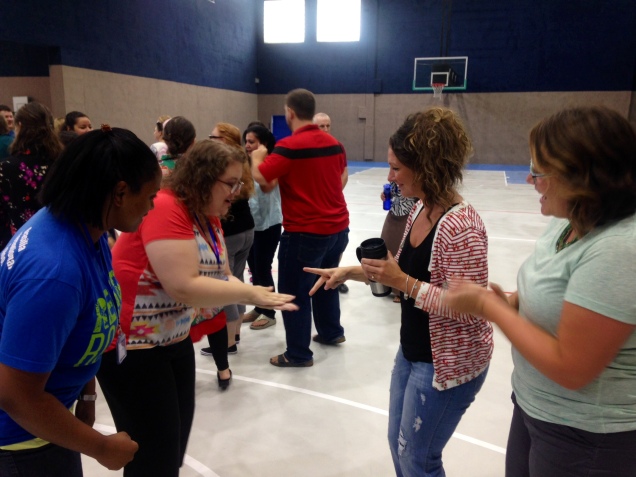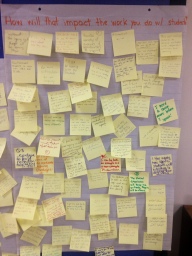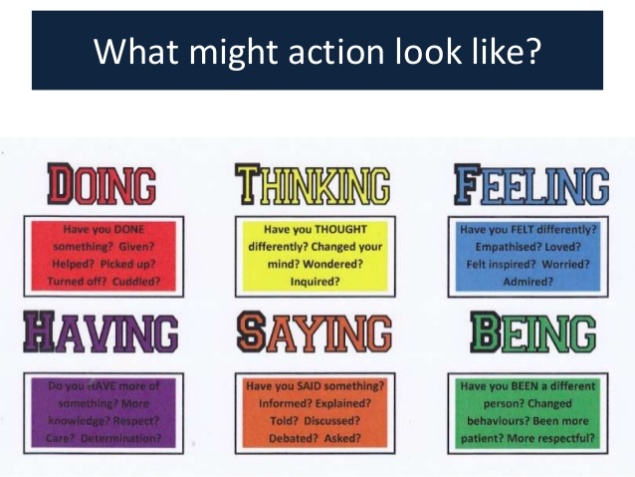This year we had 25 wonderful new staff join our Primary Years Program. As PYP Coordinator, myself and my trusty partner are charged with the privilege of training them in all things PYP. We decided this was a great chance for us – as coordinators- to participate in a process of collaborative planning and design our own Unit of Inquiry to structure our 9 one-hour sessions with our new staff. Here are the big pieces of our UOI:
We had 3 overarching goals:
- Have our new-to-PYP learn about the PYP, by learning through the PYP
- Model inquiry based, concept-driven teaching and learning practices they could take back and use in their own teaching
- Stay connected to the process of unit planning, unit delivery and unit reflection from a teaching perspective
Here is a brief (not so brief!) summary of what we did each week to hopefully accomplish these goals!
Week 1 – General overview
Diagnostic Assessment: What do you know, or think you know about the PYP?
Teachers sketched their own model of the elements of the PYP and how they work together.
Tuning in: How do you feel about your current understanding of the PYP?
Teachers wrote their name or a symbol on a post-it and stuck it to a reflection spectrum that ranged from “I don’t even know what PYP stands for” all the way to “I should take over the PYP Coordinator’s job”
Tuning in: Introducing the Unit of Inquiry
We shared the central idea, key concepts and lines of inquiry with the teachers.
Tuning in: Q&A
We facilitated an informal question and answer session and made sure to take note of questions that could guide our planning for future sessions.
Week 2 – International Mindedness
Tuning in: What is international mindedness?(Form) How does it work in the PYP?(Function)
Teachers jotted down what they think they know about the form and function of international mindedness into their “Inquiry Notebooks”.
Finding Out & Sorting Out: Resource Exploration & Visible Thinking Routine – Connect, Extend, Challenge
Teachers explored a variety of resources we provided about international mindedness and organized their ideas based on the Connect-Extend-Challenge Visible Thinking Routine.
Making Conclusions: Reflection – How might I develop IM in the grade/subject I teach?
Teachers sat with colleagues who teach the same grade or subject to chat about and brainstorm ways to put their learning about IM into action.
Week 3 – Transdisciplinary Learning
Taking Action : Reflecting on international mindedness
Teachers discussed how they had put their learning about IM into action in their own teaching and how it went.
Tuning in: Visible Thinking Routine – 3,2,1 Bridge
Teachers completed the first part of the Visible Thinking Routine “3,2,1 Bridge” about transdisciplinary learning.
Provocation: Decomposition Lab
Teachers watched this YouTube video that shows a Grade 4 transdisciplinary unit in action and discussed what they noticed.
Sorting Out: Transdisciplinary Theme Visible Thinking Routine: Chalk Talk
Teachers completed a chalk talk for each of the 6 TD themes in the PYP, brainstorming what topics or specific areas of study could be explored in that theme.
Making Conclusions & Reflection: 3,2,1, Bridge
Teachers completed the second part of the VTR “3,2,1 Bridge” and reflected on how their understanding about transdisciplinary learning had shifted and changed.
Week 4 – Concept-Based Teaching and Learning
Taking Action: Reflecting on transdisciplinary learning
Teachers chatted about how the attempted TD learning in their own teaching practice based on what they had learned the week before.
Tuning in: +1 Routine
Teachers brainstormed a list of all the pieces of information they knew about concept-based learning.
Provocation: Dr. David Perkins
Teachers read this startling statement “90% of what we teach in schools is a waste of time… it just doesn’t matter” and then watched this YouTube video of Dr. David Perkins to provoke their thinking about “what’s worth knowing?”
Finding Out & Sorting Out: Resource Exploration & Visible Thinking Routine +1
Teachers explored resources that we provided and added relevant ideas and information to their +1 routine.
Going Further: Key Concept Questions
Teachers brainstormed questions about the Kuwait Towers from each key concept lens.
Making Conclusions: Visible Thinking Routine- Headlines
Teachers wrote a “headline” that summarized their current understanding of concept-based teaching and learning
Reflection: Stop, Start, Continue
Teachers reflected on their learning so far and provided us with feedback about what we could “stop, start and continue” to better impact their learning about the PYP.
Week 5 – Attitudes and Skills
Taking Action: Reflecting on Concept-Based Learning
Teachers discussed how they had used the key concepts with their students.
Tuning in: Skills and Attitudes as Learning Targets
Teachers experienced what it is like to have learning goals/targets structured through PYP attitudes and skills
Finding out: Making the PYP Happen Jigsaw
Teachers worked in partners to research either attitudes or skills in order to share their learning with their partner. Teachers inquired into the form and function of the attitudes and skills as described by the IB in Making the PYP Happen.
Going Further: Resource Exploration & Visible Thinking Routine- See, Think, Wonder
Teachers explored provided resources and organized relevant discoveries through the VTR “See, Think, Wonder”
Reflection: Attitude Reflection
Teachers reflected and posted which PYP attitudes they used the most throughout their learning activities.
Week 6 – Action
Tuning in: Quick Write about action
Teachers took 3 minutes to write everything and anything about action in the PYP.
Finding Out & Sorting Out: Making the PYP Happen & Visible Thinking Routine- 4Cs
Teachers read the section about action in MTPYPH and pulled out “connections, challenges, concepts and changes” based on the Visible Thinking Routine.
Making Conclusions” Visible Thinking Routine- Colour, Symbol, Image
Teachers choose a colour, symbol and image to represent their understanding of action in the PYP.
Week 7 – The Role of subjects in the PYP
Taking Action: Reflecting on action
Teachers discuss how they have supported student-initiated action in their teaching recently.
Tuning in: Teachers jotted down what subjects they think make up the PYP.
Finding out: Teachers split up into groups and each group inquired into the role of different subjects in the PYP.
Making Conclusions: Teachers presented their findings to each other.
Week 8 – Summative Sharing
Check out this post to see a full recap of the provocative “PYP test” and real PYP summative!
Week 9 – Personalized Learning Plan
Even though our new-to-PYP staff training was coming to an end we did not want the learning or support to stop. We helped our new-to-PYP staff develop Personalized Learning Plans for the remainder of their first year in the PYP.
Tuning in: Teachers reflected on their current learning about the PYP and identified areas they wanted to pursue further. They set their own “learning objectives” based on what they want to learn more about.
Finding Out & Sorting Out: Teachers explored the OCC and this google doc to find resources that would support each of their learning objectives. Teachers browsed, skimmed, bookmarked, printed, and copied links that would be of interest later on when they had time to dive in. The idea is to invest all the time it takes to find, vet and organize resources so that for the remainder of the year, if there is a pocket of time to learn you already have everything you need!
After our last session, we knew what we had to do… REFLECT! So, true to our goal of treating this like a Unit of Inquiry, my partner and I sat down together and collaboratively completed the PYP unit reflections.
We also completed an inquiry self-reflection to help us identify how many ‘signals of inquiry’ were present in our adult learning community and if there we any ‘warning bells’.
We discovered that next year we need to work on noticing, honouring and using our learners’ questions more to drive the inquiry and better build an environment filled with wonder and curiosity. We also noticed that after 9 weeks our new-to-PYP teachers learned so much about the PYP yet we never “taught” them anything, in the traditional sense. There were no Powerpoints filled with information. There were no lectures. There was no standing and delivering. That felt good!
What a great experience it was to plan, deliver, assess and reflect on our new-to-PYP staff training as a PYP Unit of Inquiry! We can’t wait to have a second chance next year to put our reflections and new goals into action!
We would love your feedback about our Unit of Inquiry! Please share your questions, comments, connections and suggestions with us.

